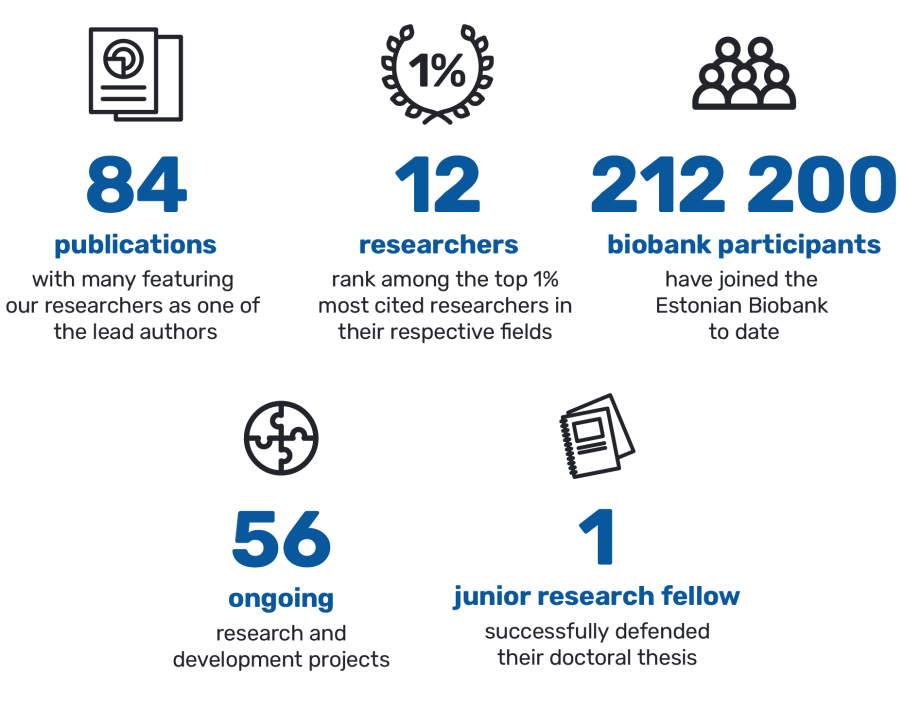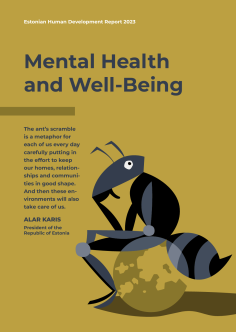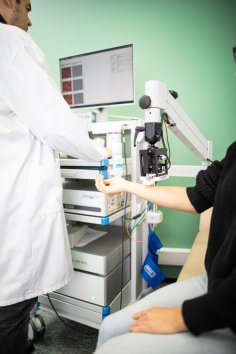The Year 2023 of the Institute of Genomics
able of contents
Foreword

As the unified Institute of Genomics at the University of Tartu, we have been at the forefront of genomic research in Estonia for six years. Although the institute is relatively young, the experience amassed by the Estonian Biocentre and the Estonian Biobank — or, more importantly, the collective expertise of our people — spans decades. In 2023, we have further strengthened our foundation, and in the following overview, we highlight some notable achievements.
The scientists at the Institute of Genomics continue to be at the forefront on a global scale. This is confirmed by various rankings, publications in high-impact scientific journals, and research grants received for innovative research and development projects. The investment in cutting-edge technology is also significant — this year, our core laboratory acquired the Illumina NextSeq 2000 sequencer, enabling even more precise sequencing experiments.
Our objective is to actively participate in the implementation of scientific advancements. Although the integration of personalised medicine solutions into the healthcare system is progressing more slowly than hoped, significant steps were taken this year. The project "Implementation of Personalised Medicine in Estonia", led by the National Institute for Health Development, concluded, and the Institute of Genomics played a role in completing the national personalised medicine IT infrastructure and training over 500 healthcare professionals.
Nevertheless, the journey towards personalised medicine is not yet complete. As one of the subsequent steps, we are involved in developing a centre of excellence for personalised medicine. This initiative aims to facilitate closer collaboration across various scientific disciplines, from clinical medicine and public health to social and data sciences, to explore all stages of implementing personalised medicine.
Finally, we have not forgotten the invaluable contribution of the biobank participants from the Estonian Biobank, who have played a crucial role in advancing genomic science. The data of all biobank participants have undergone initial genotyping analysis, and researchers from the Estonian Genome Center at the University of Tartu alone have published over 830 research papers in peer-reviewed journals based on data from the Estonian biobank. We are working diligently to gradually share initial personalised results with biobank participants through a web portal, and we hope the initial launch of this portal will be in the early months of the coming year.
Wishing you insightful reading!
– Professor Mait Metspalu, Director of the Institute of Genomics
Overview of the year in numbers


The weaving is done by employees of the Institute of Genomics, our neighbors from the Institute of Molecular and Cell Biology, as well as Ukrainians in Tartu and other volunteers. Everyone is welcome to join the weaving process – it provides a break for the mind from work thoughts and, at the same time, allows for a small act of kindness.
Remarkable research findings
In 2023 84 papers were published where scientists from the Institute of Genomics participated or played a leading role. Estonia is one of the leaders in the field of genetics worldwide – we have a valuable dataset in the Estonian Biobank and dedicated, capable researchers. Below, we provide a brief overview of the most interesting discoveries, most of which have been published in highly reputable scientific journals.
The study of Beethoven's genome has revealed previously unknown information about his health issues and relatives

An international team of researchers successfully sequenced Beethoven's genome, extracted from his hair, uncovering new insights into both his health problems and family history. The analysis identified that Beethoven had multiple genetic risk factors for liver disease. Additionally, evidence suggested that a few months before his final illness, Beethoven contracted the hepatitis B virus, which, combined with alcohol consumption, may have been the primary cause of his fatal illness. The study also revealed that a hairlock previously believed to be Beethoven's did not originate from the composer, invalidating previous conclusions based on its analysis. Furthermore, researchers concluded that there is likely at least one case of extramarital paternity in Beethoven's paternal line, leading to discrepancies between Beethoven's legal and biological relatives when comparing DNA data and archival documents.
→ This research proved once again that studying DNA can overturn previously considered facts about the past centuries or even millennia later.
Genetic data could help to improve the efficiency of prevention

Genetics not only influences the development of diseases but also how an individual responds to treatment. In collaboration with Finnish colleagues, our scientists published extensive research results in the prestigious journal Nature Medicine. We identified over 300 genetic variants strongly associated with the use of medications for preventing cardiovascular diseases. Many of these genes were also linked to the diseases the authors focused on, but 40 discovered genes were not previously associated with those conditions. Additionally, disease polygenic risk scores combining genetic data and information about medication usage allowed the prediction of individuals who might benefit from more intensive treatment.
While current treatment decisions are based on a patient's clinical indicators (such as high cholesterol levels), this study suggests that adjusting treatment based on genetic risk information could be beneficial. This approach could improve the prediction and prevention of the development of cardiovascular diseases.
→ Considering genetic risk for adjusting treatment could help to improve the prediction and prevention of cardiovascular diseases.
Ancient DNA was used to debunk previously assumed knowledge about European prehistory
While previously it was believed that the European Ice Age cultures were quite similar, the work of an international team of researchers, including scientists from the Institute of Genomics, proved the opposite. The study analyzed a total of 356 ancient genomes, ranging from the arrival of the first modern humans in Europe about 45,000 years ago to 8,000 years ago. As part of the study, the focus was on the Gravettian culture, considered to be the first pan-European culture. Surprisingly, it was revealed that people living in Spain and France genetically differed from the inhabitants of the present-day Czech Republic and Italy. The question of why the tools and lifestyles of ancient cultures varied by region had troubled archaeologists for decades, and the recent study provided new insights. Additionally, a clear genetic difference emerged between post-Ice Age Eastern and Western Europeans. Particularly interesting was the discovery that ancient inhabitants of Germany and Russia did not interact for thousands of years, despite the absence of geographical barriers.
→ With the help of new technologies and methods for studying ancient DNA, it is now possible to extract information from even poorly preserved historical material, providing an increasingly clearer picture of human development, migrations, and cultural diversity.
The emergence of generative AI in genomics

Artificial intelligence is a term that has become commonplace in almost all discourse over the past year. However, Generative AI has been gaining significance in the field of genomics over the last several years, owing to the increased availability of computational resources and the development of deep generative models (DGM) over the past decade. Deep generative models can learn the complex structure of genomic data and can be employed for various tasks such as creating realistic artificial genomes, dimensionality reduction, and predicting biological functions. Recently, our researchers presented the first overview of generative artificial intelligence in genomics, and additionally, novel generative neural networks for large-scale genomic data generation were developed. The potential of artificially generated genomes lies in their ability to serve as privacy-preserving alternatives to real biobanks, thereby enhancing data accessibility for researchers worldwide.
→ Generative AI offers an innovative approach in genomics, allowing, among other things, the creation of artificial genomes that broaden researchers' access to diverse data.
Researchers identified new genes for acne
Acne is one of the most common skin conditions worldwide, affecting approximately 85% of teenagers and young adults during their lifetime. While it often diminishes in the mid-20s, this is not always the case. Symptoms of acne are reported by 26% of women and 12% of men even in their 40s. A significant portion of the genetic factors contributing to acne were previously unknown, but a study by our researchers sheds new light on the subject. First, a genome-wide association study was conducted using data from the Estonian Biobank, comparing a group of acne patients with a control group. The Biobank includes over 30,000 participants who either have had or currently have acne. Subsequently, data from Finnish and Dutch biobanks were also examined, revealing 23 regions associated with acne.
→ While the study has no immediate clinical implications, it offers new insights into the genetic background of acne, which could potentially contribute to the development of more effective acne treatments in the future
New research sheds light on the expansion of Bantu-speaking populations in Africa

There are approximately 350 million people who speak one or more of the 500 Bantu languages in Africa. Until now, little was known about the demographic history, genetic diversity, and complex dynamics of Bantu-speaking populations that have shaped the linguistic, biological, and cultural landscape of the African continent. In a study published in Nature, our researchers used spatial genetic modeling to examine the key hypotheses about the expansion of Bantu-speaking populations across the entire African continent, including migration routes, timescales, and contacts between populations.
The study revealed that the genetic variability of Bantu-speaking populations gradually decreases as one moves farther from West Africa. Present-day Zambia and the Democratic Republic of the Congo have emerged as important nodes of communication between different expansion routes. The findings challenge previous models of Bantu-speaking population expansion and underscore the need for a comprehensive interdisciplinary approach in future studies to better understand how the demographic history of populations influenced their linguistic development.
→ Therefore, the impact of the study is far-reaching, touching on historical linguistics, anthropology, population genetics, and biomedical research focused on the genetic diversity of African populations and their descendants.
First ever study on the genetic risk factors of ectopic pregnancy sheds light on molecular mechanisms
Ectopic pregnancy is a situation where the fertilized egg implants and develops outside the uterine cavity, most commonly in the Fallopian tubes. Out of a thousand pregnancies, approximately 20 are ectopic, making it one of the most frequent early pregnancy complications. Ectopic pregnancies cannot develop normally to full term and can sometimes threaten the life of the mother as well. It is believed that an ectopic pregnancy occurs when embryo transport is impaired, and the microenvironment of the fallopian tube becomes favourable to embryo implantation. Now, researchers have, for the first time, identified a DNA region associated with the risk of ectopic pregnancy by analysing the DNA of thousands of women. This region harbours the MUC1 gene, which encodes a glycoprotein believed to play a role in preventing embryo implantation in the Fallopian tube. Therefore, the published study provides valuable information about the mechanisms of embryo implantation.
→ The study underlines the value of large biobanks for investigating women's health and pregnancy complications.
Read the article
Neanderthal genetic heritage may contribute to severe COVID-19 outcomes
Several research groups worldwide have found that changes in the DNA on chromosome 3 are responsible for severe COVID-19 outcomes. However, it was previously unknown which specific genetic variants increase the risk of serious symptoms and why. Even before the coronavirus pandemic, our scientists started to compare samples from the Estonian Biobank participants with Neanderthal genome sequences to understand which genetic variants have survived through evolution. This led to the conclusion that certain genes inherited from Neanderthals are present in that same chromosome 3 of modern humans. Subsequently, researchers delved deeper into the topic and were able to, for the first time, link specific genetic variants inherited from Neanderthals to severe COVID-19 outcomes. Although the Estonian Biobank dataset reflects well the Neanderthal origin in the European population, conclusions about the entire human population cannot be drawn based on these data.
→ The Estonian Biobank provides rich data to investigate the impact of Neanderthal genetic heritage on contemporary Europeans.
People with depression adhere less to blood pressure medication
Epidemiological studies indicate that individuals with depression have a higher prevalence of heart diseases and also a higher mortality rate due to cardiovascular diseases. Maintaining control over high blood pressure and following physician-prescribed blood pressure medication is crucial for preventing heart diseases. Our researchers used Estonian Biobank data to study whether individuals with depression adhere less to medical advice regarding the use of blood pressure medication for preventing heart diseases. It was indeed found that individuals with depression are less likely to adhere to blood pressure medication – they purchase medication prescriptions more chaotically, and they have longer gaps in medication usage. Genetic variants associated with depression also play a role in poorer adherence to blood pressure medication. Subsequently, the researchers explored whether the treatment of depression with antidepressants affects the patterns of patients' blood pressure medication usage. It was revealed that the initiation of antidepressant treatment correlates with an improvement in patients' adherence to blood pressure medication.
→ Addressing untreated depression among patients with high blood pressure may lead to an improvement in adherence to hypertension medication.
Unique studies
As evident from the preceding block featuring scientifically engaging articles, a significant part of our research uses the valuable Estonian Biobank dataset. The following block provides an overview of recently concluded or ongoing studies wherein biobank participants play a pivotal role.
A clinical study led by UT identified completely new genetic variants that may affect medication response
Medications do not affect all individuals in the same way: some experience side effects, while others do not respond to the medication at all. The aim of this clinical study was to identify rare and common genetic variants associated with the effects and side effects of medications. In the future, primary care physicians can use this information to prescribe personalized medications for each individual or determine the appropriate dosage before starting treatment.
The study included over 100 Estonian Biobank participants, and changes in the concentration of two medications and their metabolites were assessed during the study visit. In several participants, completely deficient enzyme activity was found, leading to sustained high concentrations of the medication throughout the day.
The study is part of the project "Role of Rare and Common Genetic Variants in Adverse Drug Reactions", led by Lili Milani, Professor of Pharmacogenetics at the University of Tartu.
Estonian Human Development Report 2023

At the beginning of this year, the Estonian Human Development Report 2023 on “Mental Health and Well-being” was published, a collaborative effort involving Associate Professor Kelli Lehto and Researcher Kadri Kõiv from the Institute of Genomics. The report incorporated data collected from the Well-being and mental health study conducted among biobank participants in the spring of 2021. Our main message was clear: mental health issues are highly prevalent across the population, and many individuals do not reach the healthcare system to seek assistance. Additionally, our analysis of genomic data from the gene bank highlighted the significant role of genetic predisposition in the manifestation of depression.
The Estonian Human Development Report was compiled over two years with contributions from over 70 recognized scientists. Explore it on the Estonian Cooperation Assembly's website.
The study "Genetic Data and Health Behavior" reveals how genetic information could be used in the prevention of cardiovascular diseases
This study with 1500 Estonian biobank participants aged 25–55 is reportedly the largest study of its kind in Europe. The study assesses how knowing about a high genetic risk of coronary artery disease affects the health risks and health behavior of young individuals. Such a study is crucial to finding ways in which genetic information can be utilized in the prevention of cardiovascular diseases (such as coronary artery disease and stroke) in the future.
The successful implementation of this study depends on Estonian general practitioners who provide counseling, motivation, and, if necessary, initiate treatment for high blood pressure and cholesterol reduction. The study will end in 2024, and the results and knowledge obtained will be applied to implementing personalized medicine in the Estonian healthcare system.
The study is part of the international project called INTERVENE – International consortium for integrative genomics prediction, led by Reedik Mägi, Professor of Bioinformatics at the University of Tartu.
Tartu residents help to clarify the impact of light on people's health and well-being

Light has a greater influence on people's daily well-being than previously thought. In collaboration between the University of Tartu and the city of Tartu, a study is being conducted on the effects of light on the health and well-being of elderly individuals. These findings will contribute to smarter planning of health-friendly and sustainable urban lighting in Tartu, as well as in other locations in Estonia and around the world.
The study includes up to 500 individuals aged over 65 from Tartu, and it is possible to join the study until mid-February 2024. Participants are divided into two groups, with one group exposed to new, biologically more suitable lighting conditions, while the other group continues to live under usual conditions.
The study is part of the European research project ENLIGHTENme, led by Toomas Haller, Associate Professor of Genomics and Metabolomics at the University of Tartu.
Estonian Biobank participants can join a diabetes study

Diabetes has become a global pandemic, affecting over 420 million people. According to the Estonian Diabetes Association, the disease has been diagnosed in about 70,000 Estonians, the majority of whom suffer from the more common form known as type 2 diabetes, also known as late-onset diabetes. However, many questions about diabetes remain unanswered. For example, it is not yet precisely known who may develop diabetes over their lifetime and why some individuals experience complications earlier than others.
To find answers to these questions, we are conducting a study among biobank participants to explore possibilities for improving the management of type 2 diabetes in healthcare. The focus is particularly on investigating the risk of developing type 2 diabetes and associated diseases, aiming to better monitor the disease in the future and prevent the onset of complications. Biobank participants over the age of 40, regardless of whether they have diabetes, are invited to participate in the study via email.
The study is part of the larger international project OPTOMICS, led by Reedik Mägi, Professor of Bioinformatics at the University of Tartu.



